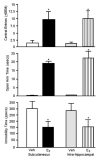A review and update of mechanisms of estrogen in the hippocampus and amygdala for anxiety and depression behavior
- PMID: 16554740
- PMCID: PMC3624621
- DOI: 10.1038/sj.npp.1301067
A review and update of mechanisms of estrogen in the hippocampus and amygdala for anxiety and depression behavior
Abstract
Estrogen (E2) has many effects in the central nervous system, including effects on anxiety and depression behavior. This review will address effects of E2 on behaviors related to anxiety and depression in women and animal models and include recent findings from our laboratory related to this topic. E2's antianxiety and antidepressant-like effects may depend upon many factors, including the regimen of E2 utilized and interactions with the hypothalamic-pituitary-adrenal axis. Brain targets for E2's effects on anxiety and depression include the hippocampus and amygdala. Administration of E2, compared to vehicle, subcutaneously or to the hippocampus or amygdala of ovariectomized rats decreases anxiety and depressive behavior. Intracellular estrogen receptors (ERs) may be important for E2's anxiolytic and antidepressant-like effects. Administration of an ER antagonist to the hippocampus, but not amygdala, increases anxiety and depression behavior of naturally receptive female rats. Studies utilizing ER knockout mice or selective ER modulators suggest that ER-mediated effects of E2 on anxiety and depressive behavior may require ERbeta. In addition, the behavioral effects of E2 may involve membrane actions and/or changes in cell cycle processes involved in energy expenditure. Elucidating the mechanisms by which E2 affects anxiety and depression is important in order to enhance its therapeutic potential. It is particularly important to investigate the putative receptor mechanisms and brain targets for E2 to determine whether mood-enhancing effects of E2 can occur without deleterious proliferative effects in reproductive tissues.
Figures



References
-
- Ahokas A, Kaukoranta J, Wahlbeck K, Aito M. Estrogen deficiency in severe postpartum depression: successful treatment with sublingual physiologic 17beta-estradiol: a preliminary study. J Clin Psychiatr. 2001;62:332–336. - PubMed
-
- Almeida OP, Lautenschlager N, Vasikaram S, Leedman P, Flicker L. Association between physiological serum concentration of estrogen and the mental health of community-dwelling postmenopausal women age 70 years and over. Am J Geriatr Psychiatr. 2005;13:142–149. - PubMed
-
- Altemus M, Redwine LS, Leong YM, Frye CA, Porges SW, Carter CS. Responses to laboratory psychosocial stress in postpartum women. Psychosom Med. 2001;63:814–821. - PubMed
-
- Baca-Garcia E, Diaz-Sastre C, deLeon J, Saiz-Ruiz J. The relationship between menstrual cycle phases and suicide attempts. Psychosom Med. 2000;62:50–60. - PubMed
-
- Bebbington P, Hurry J, Tennant C, Sturt E, Wing JK. The epidemiology of mental disorders in Camberwell. Psychol Med. 1981;11:561–579. - PubMed

